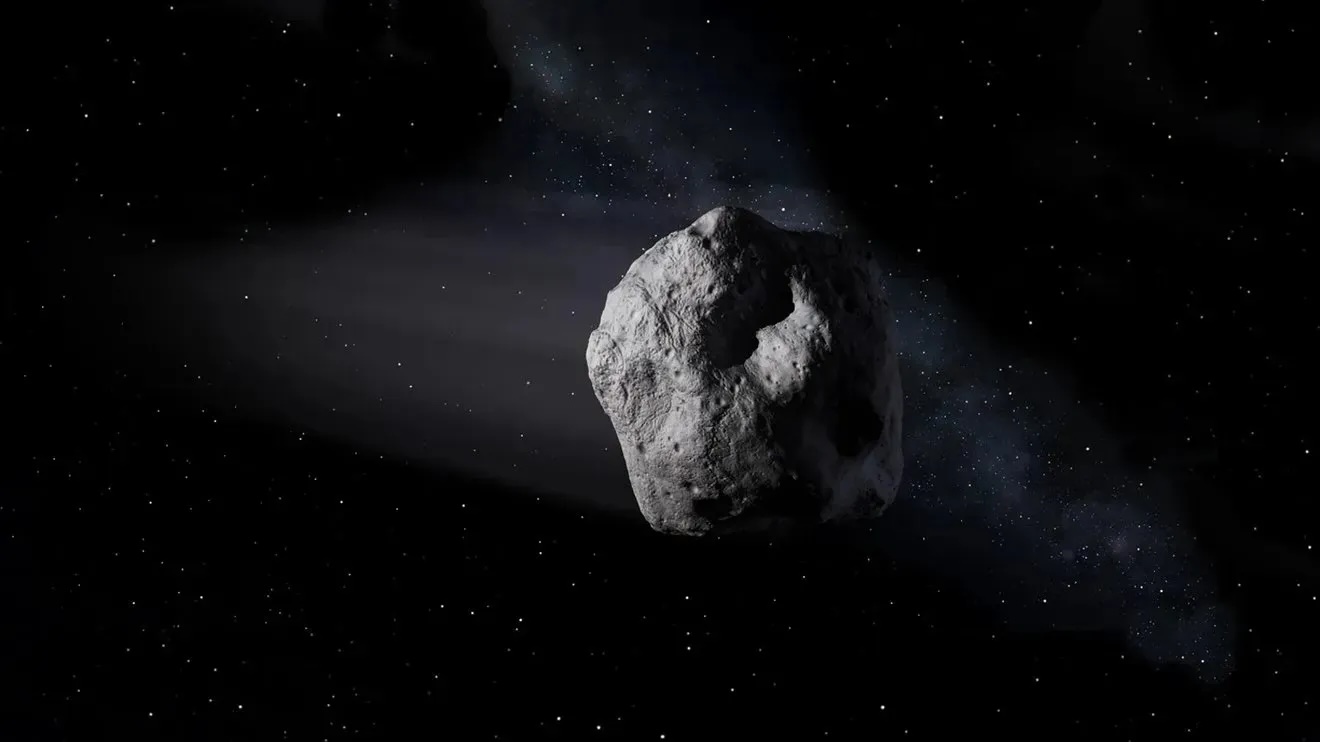When you purchase through contact on our site , we may realize an affiliate commission . Here ’s how it works .
Scientists using theJames Webb Space Telescope(JWST ) have identified a component part of water on the mystic metal - rich asteroid Psyche . The findings hint the hydration live as rust and may shed lightness on how this enigmatic object formed .
The asteroid16 Psycheis fairly unusual for the principal asteroid belt between Mars and Jupiter . Measuring an enormous 173 miles ( 280 kilometers ) at its widest , the potato - shaped target was once thought to be completely metal . Psyche ’s supershiny surface had led researchers to suggest the asteroid was possibly the branding iron - rich heart of a planetesimal ( a planetary building block ) and could untangle how Earth and the other mundane planets take shape . Some havevalued the asteroid ’s rare metallic element components at $ 100,000 quadrillion — a real goldmine in space .

An illustration of the metal-rich asteroid Psyche. James Webb Space Telescope data suggests the hydroxyl groups on Psyche are probably bound to metal on the asteroid’s surface, forming rust.
This hypothesis about the rock ’s composing , in fact , is what motivatedNASA ’s ongoingPsyche delegation . Launched in October 2023 , it ’s look to reach the asteroid in 2029 to study it in - depth .
But all that scintillation is n’t aureate — or even metallic element . Over the past times 10 , Modern data point about Psyche ’s denseness and reflection factor spectra — the intensity of dissimilar wavelengths of sunshine reflect off the asteroid ’s surface ― intimate it is most likely a mixed silicate and metal world .
refer : NASA ’s most wanted : The 5 most dangerous asteroids to Earth

An artist’s illustration of the James Webb Space Telescope.
In 2017,researchers discovered tantalizing tracesof another portion : water . Spectra from the infrared region , at farseeing wavelengths that we perceive as heat but ca n’t see , showed the signature of hydroxyl unit of measurement — the OH speck , which forms part of piddle .
These results suggested Psyche ’s surface may hold in small measure of piss , as either ice or hydrous minerals . But the results were inconclusive , since the spectrum , call for usingNASA ’s ground - based Infrared Telescope Facility in Hawaii , may have been corrupted by water in Earth ’s atmosphere . Besides , the investigator had n’t found a more classic touch of water from a slenderly higher infrared wavelength . That theme song has helped other stargazer " notice far-flung molecular water on the Moon but had not yet been used for asteroids , " study authorStephanie Jarmak , a planetary scientist at the Harvard and Smithsonian Center for Astrophysics , recite Live Science in an e-mail .
To determine if Psyche really has urine , Jarmak and scientists from several U.S. and German institute turned to two of JWST ’s infrared - sensing instruments : the Near Infrared Spectrograph ( NIRSpec ) and the Mid - Infrared Instrument ( MIRI ) , which can discover shorter and longer infrared wavelength , respectively . By directing these instruments toward the asteroid in March 2023 , the scientists pull together snapshots of the spectrum reflected by Psyche ’s magnetic north terminal , which was then facing the telescope . Their resultant have been take by the Planetary Science Journal and are available as apreprint via arXiv .

The NIRSpec data point showed the hydroxyl signature , confirming its presence on the asteroid . What ’s more , Jarmack noted , the high - quality datum allowed comparisons with hydroxyl signature from other meteorites , revealing that Psyche ’s hydroxyl key signature resemble that from sure rust - bearing , carbon - rich meteorites . This finding led the research worker to conclude that hydroxyls are bonded to metal on Psyche , forming rust .
But the MIRI data miss the conclusive signature of water . Still , the investigator ca n’t find out the presence of water , as it could be present on other parts of Psyche that JWST could n’t see . It ’s also possible that water is present but at concentrations below MIRI ’s detection limit , pretend it less than half the assiduity ofwater on the moon , which is itself only a raindrop ’s equivalent in 2.25 pounds ( 1 kg ) of soil .
— Undiscovered extra moons may revolve Earth . Could they serve us become an interplanetary coinage ?

— NASA find water on the moonlight ’s sunstruck surface for the first time
— There ’s an asteroid out there worth $ 100,000 quadrillion . Why have n’t we mined it ?
aside from form rust , Psyche ’s hydroxyl grouping provide hints about how the asteroid organize . If the hydroxyl formed within the asteroid , this could indicate Psyche was born in the cold , out bounds of thesolar systemand tottered in over jillion of days . However , the existing evidence suggests water - bearing asteroid impactors that slammed into Psyche and shaped it also brought the hydroxyl .

succeeding plan let in studying on the button where the hydrated metals are found on Psyche ’s airfoil , Jarmak enounce , tot up that these include " observation of Psyche ’s south terminal that comprise a heavy crater that may have result from an encounter with a hydrated impactor . "
alloy - rich asteroids are lucrative source of rare mineral and the guinea pig of future blank space mining ventures . However , despite its estimated note value , Psyche is n’t among them — at three clip Earth ’s aloofness from the sun , it ’s too far for extraction attempt to be toll - effective .














